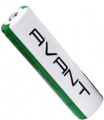Capacity
The rated capacity of a battery is the amount of energy it can store.
This parameter directly determines how long the power supply can operate with a particular load. However, when assessing capacity, there are two things to consider. First, the capacitance rating is usually specified for a specific discharge power. So, for salt and alkaline full-size batteries (see “Technology”), this power is measured in tens of milliamps. But if it is significantly exceeded (on the order of hundreds of milliamps), the actual capacity of the battery may decrease significantly compared to the declared one. Therefore, for example, it is not recommended to use disposable batteries in digital cameras - the power consumption in such equipment can exceed 1000 mAh, and NiMh batteries cope best with such a load. And miniature silver-zinc batteries of the “300” series (SR) are available in two versions - for high and low discharge power; CR series button batteries can have a similar low-power version (for more details on both, see “Size”). More detailed information on discharge currents for different types and sizes of batteries/accumulators can be found in special sources; and in some cases (mainly for lithium-ion batteries) it is directly specified in the characteristics (see “Nominal discharge power”, “Maximum discharge power”).
The second caveat is that the actual energy reserve depends not only on the number of milliamp-hours declared, but also on the operating voltage;...so you can only compare by numbers in mAh batteries/accumulators with the same voltage (in extreme cases, with a similar voltage, for example, 3 V and 3.6 V). However, other comparisons are rarely required in practice.
Maximum discharge current
The maximum discharge current provided by the battery is the maximum current that the battery can deliver without the risk of overloading, overheating and other troubles. This indicator directly determines compatibility with a specific device: the current consumed by the load must not exceed the maximum battery discharge current.
The maximum discharge current is indicated only for rechargeable batteries (see "Type"). By definition, it is greater than the nominal one (see above), but it is worth recalling that when the rated current is exceeded, the voltage at the battery output decreases. Therefore, in some cases, it is necessary to choose a battery exactly according to the rated discharge current.
Protection board
Built-in electronic circuit that protects the battery from operating conditions.
This function is found mainly in lithium-ion batteries (see “Technology”). This is due to the fact that such batteries have fairly strict charging and discharging rules; violation of these rules (primarily overcharging and overdischarging, as well as overcurrent) can lead not only to battery failure, but also to fire and even explosion. To avoid such troubles,
protection boards are used: they primarily control the charge level, as well as charging and discharging power.
This feature is highly recommended if the battery is to be used in a device that does not have its own battery controller. A striking example is electronic cigarettes with mechanical battery mods, in which the atomizer coil is connected to the battery virtually directly. Without a protection board, the customer must carefully control the operating mode himself - and this is not so easy, given the absence of any additional indicators in the same “mechanical mode”.
On the other hand, it is worth considering that this function affects not only the cost, but often also the dimensions of the battery - it can increase its length by several millimeters beyond the nominal size. For example, 18650 elements with a protection board are not 65 mm long, but about 68 mm. In some cases, this can create problems with installation, or even make it impossible. So if the device fo
...r which the battery is purchased has its own protection circuits, the optimal choice for such a load would be a regular, “unprotected” power source.
